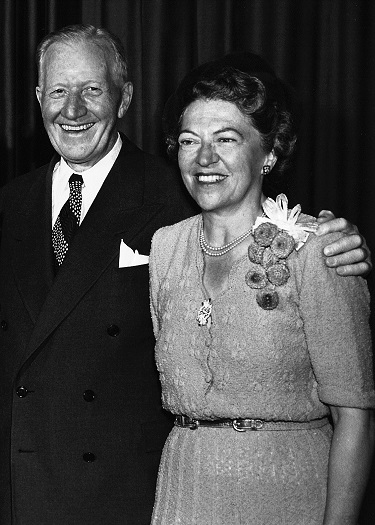Dr. Ezekiel and Edna Wattis Dumke focused much of their philanthropic giving on the people and institutions who care for patients.
They pushed Ogden leaders to build a hospital for soldiers during World War II, mentored generations of physicians in their hometown and, ultimately, shored up the educational institutions that will prepare future Utah healthcare providers for generations to come.
Fitting, then, that the foundation they started nearly 60 years ago has provided startup funding for the Utah Nursing Consortium—an initiative of the state’s eight publicly funded nursing schools, Brigham Young University and Westminster College.
With a grant provided by the Dr. Ezekiel R. and Edna Wattis Dumke Foundation, Utah’s nursing schools banded together in 2016 to persuade state lawmakers that a little extra funding for faculty could help reverse a growing nursing shortage. The foundation’s initial gift helped pay for materials and the staff who led the campaign during the 2017 Legislature. Foundation leaders have pledged another $150,000 to support the effort in future years.
The Consortium was a natural initiative for the foundation to support, says Claire Dumke Ryberg, a 1977 College of Nursing graduate and the couple’s granddaughter.
“The need for nurses started coming to the fore and has compounded over time with changing demographics,” Ryberg says. “Every time we asked nursing deans, ‘What is your greatest need?’ They always said ‘faculty’ — which is not very tangible or often measurable.
“But while our foundation can’t continually fund nursing schools over the years to close this gap, we decided maybe we could become more proactive and initiate a consortium that might be able to solve the problem. It is a more strategic approach for us.”
The organization’s mission has evolved over time. When the family foundation first started in 1958, Zeke and Edna first provided loans for 28 medical students in financial distress. In later years, their children and grandchildren targeted medical research, conserving land, building medical simulation labs and constructing science classrooms at Weber State University and the University of Utah.
“They knew and appreciated the hardship that it required for young people to become doctors. And the West still was a medical frontier; it was emerging,” Ryberg says. “They wanted to pay it forward. We learned the value of philanthropy and what it can do from our grandparents and parents.”
Zeke Dumke was born in 1886 in Manitowac, Wisconsin. His father, a German immigrant, owned a shoe store. After high school, Dumke did a stint in blue-collar work -- at a cement company and later at a shipyard. But when a co-worker was injured on the job, Dumke decided he wanted a career with more prospects for the future. He studied two years at Denver University, visiting Utah as a player for the college’s football and basketball teams. After graduating from Northwestern University Medical School in 1910, Dumke interned at a hospital in Denver and later at Salt Lake City’s LDS Hospital. In 1911, he moved to Ogden to work as an assistant to an established physician and met his future wife, the daughter of a Utah coal magnate, at a party at her home.
Edna Wattis was born in Ogden in 1896, one of eight children of mining and railroad executive E.O. Wattis and Martha Ann Bybee. Wattis’ Utah Construction Company built the Western Pacific Railroad, the Denver and Rio Grande lines in central Utah, and helped build the Hoover Dam and Geneva Steel Plant as part of Six Companies, Inc.
In 1915, Dumke left Utah to complete post-graduate work at Massachusetts General Hospital, the University of Pennsylvania and the Mayo Clinic (and to give Edna time to grow up). Two years later, he returned to Ogden, marrying his sweetheart, launching a private practice and working as a surgeon for the Bamberger Railroad and Utah Power and Light Company. When war broke out, Dumke he enlisted in the Medical Reserve Corps, serving throughout the country in military hospitals before returning to Ogden to resume his practice.
Throughout Ogden, tales of Dumke’s care for patients and humanitarianism are common. He helped heal a newsboy’s badly burned legs. In a video tribute prepared by Weber State University, Dr. Daniel Hunter recalled struggling to support his young family on his $61-a-month salary as a young physician. The Dumkes stepped in with a loan. They “helped us to survive,” Hunter said.
Zeke died in 1961, Edna in 1982. Since then, their foundation has given to many nonprofit organizations and charities — including the Egyptian Theater Foundation, Children’s Aid Society and Treehouse Children’s Museum. Ogden’s Union Station features a model train exhibit the foundation funded in honor of Edna’s father.
But an emphasis of the Dumke Foundation board members—Zeke Dumke, Jr.; Ryberg, Nancy Healey Schwanfelder and Andrea Dumke Manship--has been focused on continuing and broadening the Dumke healthcare legacy, providing $1 million for Weber State University’s College of Health Professions, another $500,000 in student scholarships, and $2 million for an endowed professorship in the college. At Westminster College, the foundation was pivotal in helping start a program for nurse anesthetists. And at the University of Utah, the foundation has provided more than $3.4 million in smaller individual gifts for everything from poison control and nursing distance learning to a Native American art program at the Utah Museum of Fine Arts.
Senior Advancement Director Dinny Trabert credits the foundation for initiating the consortium and steering the foundation to advocate for future nurses.
“Claire has been one of our greatest advocates with the foundation and in the community,” Trabert said.
